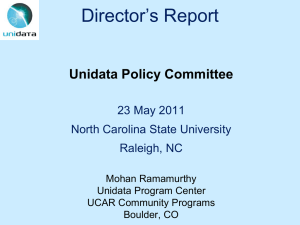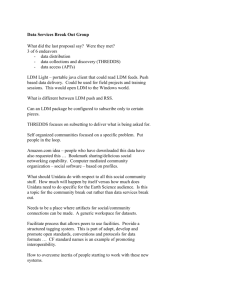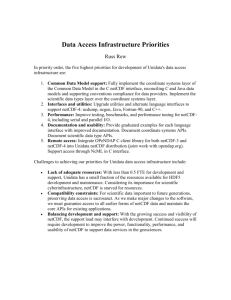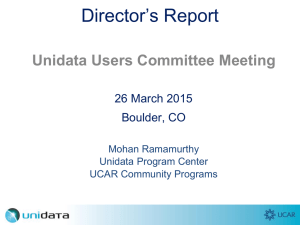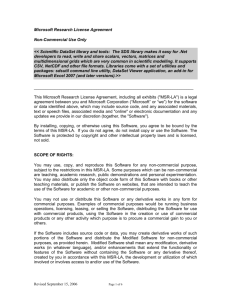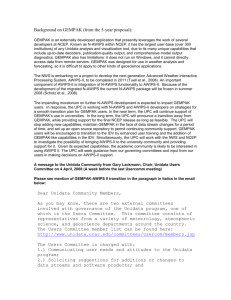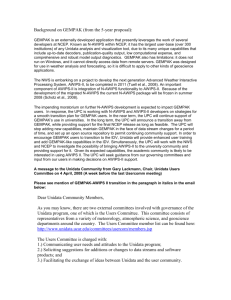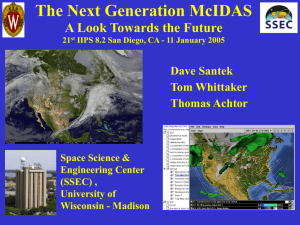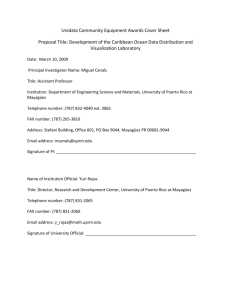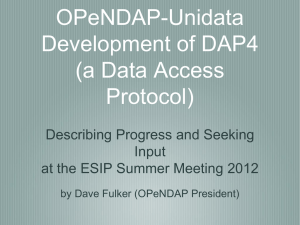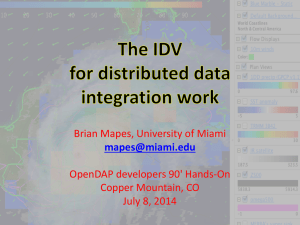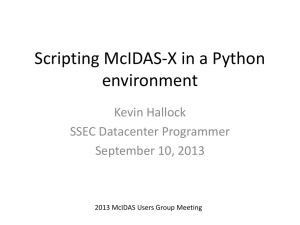Unidata
advertisement
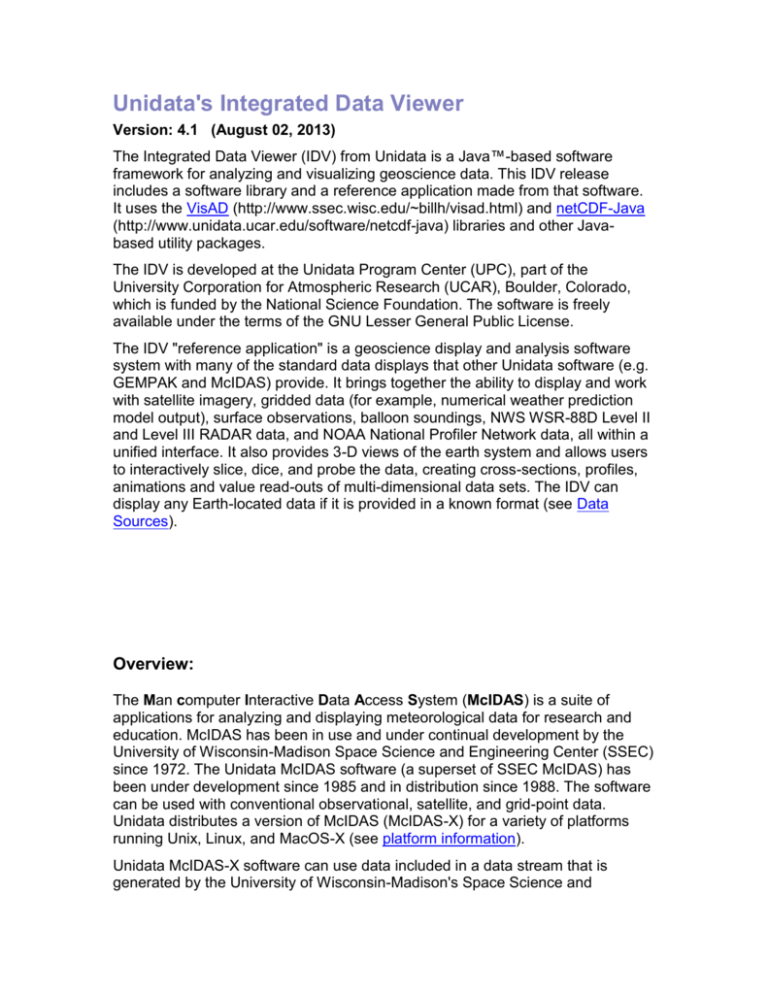
Unidata's Integrated Data Viewer Version: 4.1 (August 02, 2013) The Integrated Data Viewer (IDV) from Unidata is a Java™-based software framework for analyzing and visualizing geoscience data. This IDV release includes a software library and a reference application made from that software. It uses the VisAD (http://www.ssec.wisc.edu/~billh/visad.html) and netCDF-Java (http://www.unidata.ucar.edu/software/netcdf-java) libraries and other Javabased utility packages. The IDV is developed at the Unidata Program Center (UPC), part of the University Corporation for Atmospheric Research (UCAR), Boulder, Colorado, which is funded by the National Science Foundation. The software is freely available under the terms of the GNU Lesser General Public License. The IDV "reference application" is a geoscience display and analysis software system with many of the standard data displays that other Unidata software (e.g. GEMPAK and McIDAS) provide. It brings together the ability to display and work with satellite imagery, gridded data (for example, numerical weather prediction model output), surface observations, balloon soundings, NWS WSR-88D Level II and Level III RADAR data, and NOAA National Profiler Network data, all within a unified interface. It also provides 3-D views of the earth system and allows users to interactively slice, dice, and probe the data, creating cross-sections, profiles, animations and value read-outs of multi-dimensional data sets. The IDV can display any Earth-located data if it is provided in a known format (see Data Sources). Overview: The Man computer Interactive Data Access System (McIDAS) is a suite of applications for analyzing and displaying meteorological data for research and education. McIDAS has been in use and under continual development by the University of Wisconsin-Madison Space Science and Engineering Center (SSEC) since 1972. The Unidata McIDAS software (a superset of SSEC McIDAS) has been under development since 1985 and in distribution since 1988. The software can be used with conventional observational, satellite, and grid-point data. Unidata distributes a version of McIDAS (McIDAS-X) for a variety of platforms running Unix, Linux, and MacOS-X (see platform information). Unidata McIDAS-X software can use data included in a data stream that is generated by the University of Wisconsin-Madison's Space Science and Engineering Center and subsidized by the National Science Foundation through the Unidata Program. This datastream has for years provided the only source of fully navigated satellite data generally accessible to the university community in near-realtime (this is changing, however, with the growing availability of GINI imagery in NOAAPORT). Unidata IDD Data Streams Containing Imagery presents information on the products currently available to Unidata IDD users including those in the Unidata-Wisconsin datastream. Unidata's Internet Data Distribution (IDD) system provides access to an even greater range of data. Sites using the McIDAS-X software can make use of this data by installation of an add-on package of decoders called McIDAS-XCD. Unidata bundles McIDAS-XCD with its releases of McIDAS. McIDAS-XCD allows sites to decode all Family of Services/NOAAPORT and High-Resolution data service data for display with the McIDAS. Features: Multiple data types. McIDAS may be used to analyze the full range of meteorological data: conventional observations, FSL wind profiler, NLDN lightning, gridded numerical forecast, NEXRAD radar, satellite data, etc. Access to satellite imagery. The McIDAS software can be used to analyze any of the major satellite data sets: GOES, POES, METEOSAT, GMS, MODIS, FY-2, etc. McIDAS allows the user to: o view a time sequence of real-time satellite images o track cloud motions o color enhance displayed images o combine satellite imagery in a variety of ways to create products Standard meteorological analysis programs. The software can perform standard meteorological analyses for conventional observation and gridpoint data. McIDAS allows the user to: o overlay surface and upper air contoured analyses on satellite imagery o calculate derived parameters o display thermodynamic diagrams Fully navigated displays. All earth-depicting displays produced by McIDAS are fully navigated; earth positioning is available for every point on the screen. Multiple visualizations. Observational data can be analyzed into gridpoint data, and grid-point data can be transformed into image visualizations. Multiple graphic overlays. Remapping of images into other coordinate projections. Multiple frames and windows. McIDAS has multiple frames for image and graphic displays and multiple windows for text; the number of frames is defined by the user and limited only by workstation resources. Image and graphic storage. McIDAS can store images and graphics in internal memory for quick redisplay and for combining displays into an animation. Scheduled operations. McIDAS includes a scheduler facility that allows sites to create analyses at user-specified times. Tools for site-specific software development What is GEMPAK? What is the gembud mailing list, and how can I subscribe? GEMPAK Information. GEMPAK, the GEneral Meteorology PAcKage, is an analysis, display, and product generation package for meteorological data. It is developed by NCEP (the National Centers for Environmental Prediction) for use by the National Centers (Storm Prediction Center (SPC), Tropical Prediction Center (TPC), Aviation Weather Center (AWC), Hydrologic Prediction Center (HPC), Marine Prediction Center (MPC), Environmental Modeling Center (EMC), etc.) in producing operational forecast and analysis products such as those distributed as Redbook Graphics and others displayed on the NWS web pages and utilized internally within the centers. Graphical User Interfaces provide convenient access to interactive data manipulation. A comprehensive set of decoders enables integration of real-time and archive data, products, and bulletins. The GEMPAK distribution consists of a suite of application programs, Graphical User Interfaces (GUIs), meteorologic computation libraries, graphic display interfaces, and device drivers for the decoding, analysis, display and diagnosis of geo-referenced and meteorological data. The Unidata Program Center distributes and provides support for GEMPAK to our member sites. Membership in Unidata is open to U.S. colleges and universities, and is free of charge. GEMPAK is also available as unsupported software without charge to organizations which do not participate in Unidata through the limitations specified in the Unidata participation policy. The Unidata program center release of GEMPAK/NAWIPS incorporates several additions developed both locally and at other locations to enhance the use of real-time data aquired through the Unidata IDD, and through instructional case studies such as those developed at COMET. GEMPAK provides a powerful interactive user environment for research and education in addition to operational forecasting. Many sites also utilize GEMPAK's text interface programs for classroom and web product generation as well as research and operational/real-time displays through scripts and product generation files. An example of GEMPAK utility within the Unidata community is the IDD data stream delivering facsimile replacement products (eg, the DIFAX feed) generated at the University of Wisconsin. GEMPAK is also being used to generate radar mosaics for the Unidata IDD FNEXRAD data stream by compositing individual NIDS products into a common projection and data set. These products are available to Unidata sites both in the form of images, as well as numerical grids which can be used in diagnostic calculations with other gridded data sets to produce additional value added data. For more information, see Examples of GEMPAK analysis and display capabilities and the online tutorial. AWIPS II Overview What is AWIPS II? AWIPS II is a weather forecasting, display and analysis package currently being developed by the National Weather Service. AWIPS II is a Java application designed to eventually run on multiple platforms, and it incorporates many open source technologies such as Apache Qpid, Postgres and PyPIES. The two major components of AWIPS II are the CAVE Client: a set of "perspectives" (view-modes) for visualizing data; and the EDEX Server: the dataprocessing backend with request services running. Thus a CAVE Client may connect to any properly configured EDEX Server to request and display data. When will AWIPS II be Released? Unidata will release AWIPS II when all software components are supported on 32 and 64-bit RHEL6 platforms. AWIPS II is operational forecasting software, and much of the current support of AWIPS II is for operational environments. The software will be ready for release to research and academic organizations when the following criteria are met: 1) RHEL6 support, 2) stable 64-bit standalone EDEX servers, 3) stable, fully-capable Linux and Windows clients, 4) GEMPAK command line program integration is complete. How far along are we on these goals? 1. 2. 3. 4. RHEL6 Support - Expected late 2013 64-bit EDEX Data Server - Expected early 2014 Stable Clients - 2014 GEMPAK Integration - 2014
